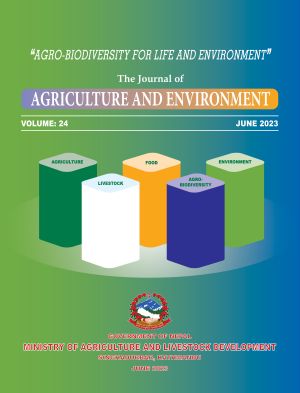Time of Harvest as the Determinant of Dry Matter Productivity and Chemical Composition of Field Pea (Pisum sativum) and Oat (Avena sativa) and their Mixture in the Abandoned Lands of Subtropical Terai Nepal
DOI:
https://doi.org/10.3126/aej.v24i01.58200Keywords:
Chemical composition, cutting stages, grass-legume mixture, mix-croppingAbstract
The grass-legume mixture formulation is an important criterion to improve biomass availability with an improved balance of the nutritive components. The objective ofthis reseach was to determine the yield and forage quality traits (green fodder yield, dry matter yield) and chemical composition (protein, fibre and mineral contents) of field pea (Pisum sativum) and oat (Avena sativa) and their mixtures under subtropical conditions. The experiment was performed over 4 months (December 2018 to March 2019) at Agriculture and Forestry University Livestock Farm, Rampur, Chitwan, Nepal, using four different treatment mixture rates of pea and oat crops. Treatments were; treatment-1 - 100% Pea+0% Oat, treatment-2 - 75% Pea+25% Oat, treatment-3 -50% Pea+50% Oat and treatment-4 - 25% Pea+75% Oat) and samples were collected in three different cutting stages (the jointing stage of oat, the stage oat in scabbard and milk dough stage of oat). The plant height was affected by the growing days while the tillers and branches in peas respectively were affected by both the time of harvest and the seed proportions. According to the results, it is suggested that the highest dry matter productivity was observed in 75% pea mix with 25% oat in the 3rd harvest, followed by 75% oat mix with 25% pea in the 3rd harvest. As well as, within intercrops, the best protein yield was obtained in a 50% oat mix with 50% pea (16.73%) at 1st harvest oat-pea intercropping. Besides, the pea + oat mixture should be harvested at the milk-dough stage of oat for better protein content and to increase the nutritive value of forage.




